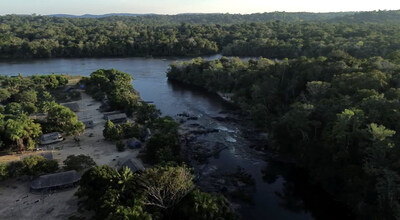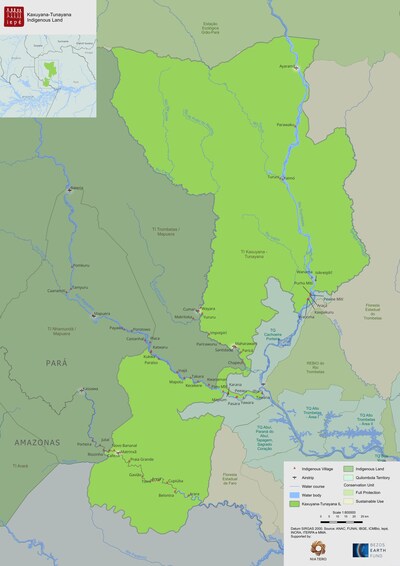
Nia Tero Celebrates Indigenous-Led Victory in the Demarcation of Kaxuyana-Tunayana and Additional Territories
Today's announcement results in stronger protections and greater self-determination for Indigenous peoples in 20 areas, with 4 Indigenous Lands reaching final demarcation in the Amazon, representing a total of 2.4 million hectares.
SEATTLE, Nov. 18, 2025 /PRNewswire/ -- Nia Tero, an international organization solely focused on supporting Indigenous Peoples' guardianship of their homelands, celebrates with the Indigenous people of the Kaxuyana-Tunayana land and other territories that formally completed the process of final recognition.
Announced by the Brazilian government during COP30, this decision will provide greater environmental protections and self-determination for the original peoples of the following areas: Kaxuyana-Tunayana, Uirapuru, Manoki, and Estação Parecis Indigenous lands. The most extensive of these by far is the Kaxuyana-Tunayana land demarcation, spanning over 2.1 million hectares, or 88 percent of the total area demarcated as part of today's announcement.
In addition to the Indigenous lands that have reached the final stage of recognition, 16 other Indigenous territories advanced in the recognition process by the Brazilian government, totaling progress in 20 Indigenous territories as part of the COP30 announcements.
"The original peoples whose territorial demands have been recognized today have won a victory for their descendants, their homelands, and this world that relies on a healthy Amazon," said 'Aulani Wilhelm, CEO (Kanaka 'Ōiwi) of Nia Tero. Nia Tero is an international organization whose entire purpose is to support Indigenous Peoples' guardianship of their homelands. "Their self-determination and the health of these lands go hand-in-hand. As we look to the global community gathered at COP30, we remind all parties that every meaningful path to ending the climate crisis needs to include Indigenous people as the driving decision makers."
"By accelerating demarcation, the government delivers justice after centuries of waiting. It is not a favor: it is the legitimate recognition of lands that have always been Indigenous," said Nara Baré (Baré), Nia Tero, Brazil Director.
"The official recognition of the Kaxuyana Tunayana territory represents reparation for the violations suffered by my people, my relatives, my family, my grandmother Ayanaru, Grandmother Txurwara, my mother Imeriki, and my uncle Putú. My generation was born and raised away from their original territory, but with a connection to each island, stream, and forest in our territory. We suffered oppression, omission, and injustice at the hands of the State, and homologating this territory holds deep meaning of rescue and reparation. However, it does not repair the many bodies buried on foreign soil, nor does it restore the time stolen from us. But it rescues our dignity amidst so much war that we have endured. It is a step forward for our existence in the diversity that we hold as Yanas," said Angela Kaxuyana (Kahyana People), Indigenous leader at AIKATUK, and representative for the Coordination of Indigenous Organizations of the Brazilian Amazon.
"The official recognition of the Kaxuyana-Tunayana Indigenous Land consolidates more than 20 years of organized struggle, led by the Indigenous Organization AIKATUK alongside important leaders like Juventino Kaxuyana, Angela Kaxuyana, and Ana Kahyana. The final physical demarcation of the land was concluded in 2025 by the Federal University of Minas Gerais, through a Technical Cooperation Agreement between Funai and Iepé, thanks to the fundamental support of Nia Tero and the Bezos Earth Fund. Today, Brazil is correcting a historical injustice, inaugurating a new cycle of territorial and cultural strengthening for the more than sixteen peoples who inhabit this Indigenous territory, reaffirming that the protection of the Amazon begins with the recognition of indigenous rights," said Denise Fajardo, anthropologist, founding partner of the Iepé Institute, where she coordinates the Tumucumaque-Wayamu program.
Under Brazilian law, land demarcation is the process by which the government officially recognizes the territorial demands of Indigenous peoples, defines their perimeter supported by historical evidence, physically demarcates the land, and finally recognizes it with the force of law. During the physical land demarcation, technical experts set the actual, physical boundaries of the area to fall under enhanced protection and Indigenous self-determination. In support of these Indigenous guardians, Nia Tero, together with the Bezos Earth Fund, made this final step possible to ensure accuracy and help end their two-decade-plus struggle for protections and recognition of Indigenous rights.
Homologation is the final step in this process, when acknowledgment by the President triggers greater protection of the demarcated land and recognizes the rights of its Indigenous Peoples. The Indigenous Peoples of Kaxuyana-Tunayana, who have called these lands and waters home for time immemorial, have pursued this process for over twenty-two years.
Indigenous lands in northern Pará are among the most biodiverse and best-preserved of the Amazon, with some of the lowest deforestation rates in Brazil. These territories safeguard vast mosaics of intact forests, rivers, endemic species, and peoples living in voluntary isolation. Together, this forms an essential ecological corridor for climate stability and biodiversity conservation. Beyond their environmental importance, they are the ancestral homelands of Karib peoples, whose millennia-old presence, knowledge, and stewardship have been central to keeping these landscapes standing.
While these announcements are a victory first and foremost for the Indigenous peoples and living species within the demarcated areas, all of humanity benefits from the Brazilian government's decision today. Numerous studies continue to show that lands under Indigenous management have the lowest levels of deforestation, and are thereby able to provide greater ecological services, critical for climate mitigation and human wellbeing. This is of global significance for the Amazon, which holds sixteen percent of all terrestrial biodiversity, and plays a major role in maintaining global temperatures and the water cycle while serving as one of the planet's largest carbon sinks.
About Nia Tero: Our mission is to directly support Indigenous Peoples' guardianship of their homelands and elevate the role and influence of Indigenous Peoples as essential to ensuring planetary health and habitability. To learn more, visit us at www.niatero.org
About Iepé: Iepé, the Institute for Indigenous Research and Training, is a non-profit organization whose mission is to contribute to the cultural and political strengthening and sustainable development of Indigenous communities in Brazilian territory located in the Guiana Shield, so that the rights of these populations are respected. https://institutoiepe.org.br
About the Bezos Earth Fund: The Bezos Earth Fund is helping transform the fight against climate change with the largest ever philanthropic commitment to climate and nature protection. Jeff Bezos has committed $10 billion in this decisive decade to protect nature and address climate change. By providing funding and expertise, we partner with organizations to accelerate innovation, break down barriers to success and create a more equitable and sustainable world. Join us in our mission to create a world where people prosper in harmony with nature: www.bezosearthfund.org
SOURCE Nia Tero










Share this article